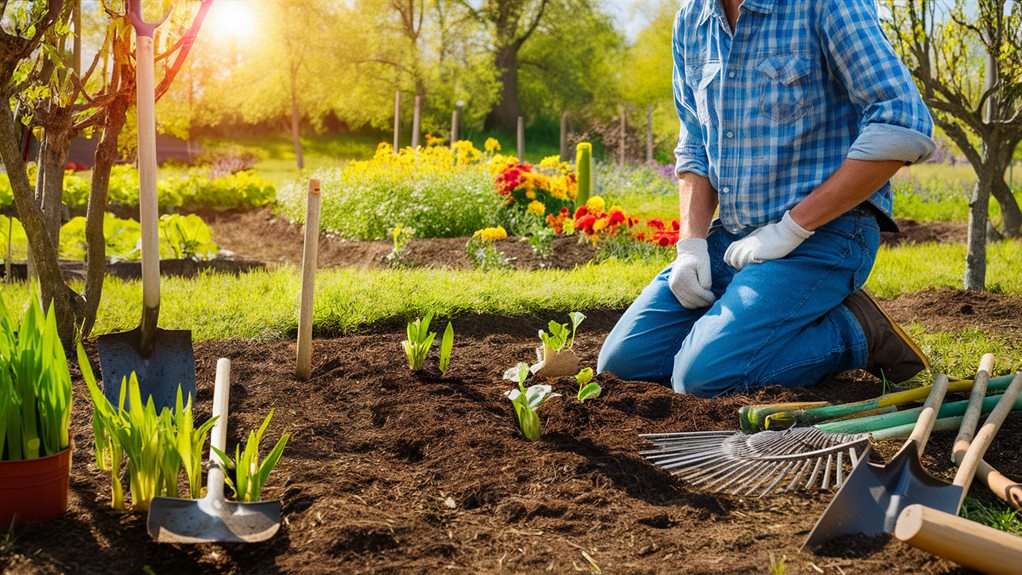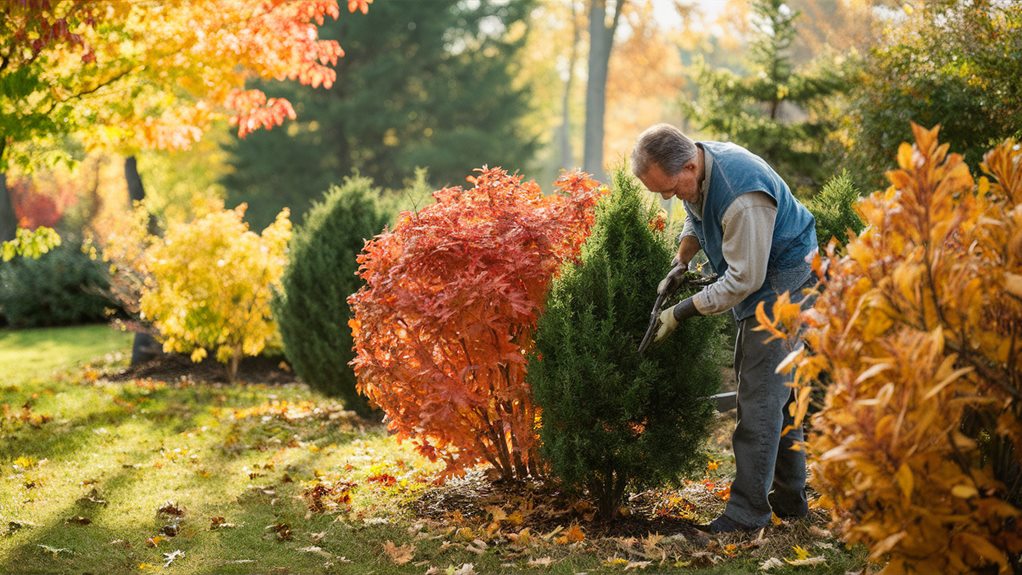To maintain a thriving garden, focus on these five essential tips. In spring, start with soil testing and enrich it with organic fertilizers and compost. During summer, water deeply and consistently, adjusting based on moisture levels. In fall, prune dead growth to prepare for new growth and clear debris to prevent disease. Winter requires frost protection through mulching and row covers, while using windbreaks can shield delicate plants. Finally, regularly inspect for pests, using natural remedies as needed. Understanding these seasonal strategies can greatly enhance your gardening success, and you'll discover even more valuable insights ahead.
Key Takeaways
- Start with soil testing in spring to determine nutrient levels and pH balance for optimal plant growth.
- Implement effective watering strategies in summer, deep watering once or twice a week to ensure thorough soil moisture.
- Prune plants in the fall after leaves drop, removing dead branches to promote healthy growth and prevent disease.
- Protect plants in winter with mulch and row covers to insulate against frost and harsh weather conditions.
- Monitor for pests year-round, using natural remedies and maintaining healthy soil to strengthen plant resilience.
Spring Soil Preparation

As you prepare your garden for spring, focusing on soil preparation is essential, since healthy soil is the foundation for thriving plants. Start with soil testing to assess nutrient levels and pH balance. This step helps you understand what amendments are necessary for best plant growth. Incorporating organic fertilizers, such as Burpee Natural Purpose Granular, can provide essential nutrients and beneficial microbes to enhance soil health.
Once you've analyzed the results, consider compost application. Adding compost enriches your soil with essential nutrients and improves its structure, promoting better drainage and aeration. Aim to incorporate a layer of compost into your garden beds to create a nutrient-rich environment for your plants.
After you've amended your soil, don't overlook the importance of mulching. Applying a layer of organic mulch provides multiple benefits, including moisture retention and temperature regulation.
Mulch also plays a vital role in weed prevention, reducing competition for nutrients and water.
Summer Watering Strategies

Maintaining proper moisture levels during the hot summer months is essential for your garden's health and productivity. To achieve this, you'll need to establish an effective watering frequency that suits your plants' unique needs, similar to how key performance factors affect the choice of laptops for best use.
Generally, most gardens benefit from deep watering once or twice a week, allowing moisture to penetrate the soil thoroughly. This encourages root growth, helping your plants withstand the heat.
Regularly check your soil moisture by digging a small hole or using a moisture meter. If the top inch of soil feels dry, it's time to water. However, don't just rely on a schedule; adapt your watering based on rainfall and temperature fluctuations.
During particularly hot spells, you may need to increase your watering frequency to maintain adequate moisture levels.
Consider watering early in the morning or late in the evening to minimize evaporation losses. Using drip irrigation or soaker hoses can also help deliver water directly to the roots, enhancing moisture retention.
Fall Plant Pruning

After confirming your garden is well-hydrated throughout the summer, it's time to focus on autumn plant trimming. Proper trimming in the fall is vital for maintaining healthy plants and preparing them for the winter. Trimming can also help improve air circulation and reduce the risk of disease, similar to how using eco-friendly products can benefit the environment through cleaning performance.
Start by evaluating your plants' health and identifying any dead or diseased branches. This is your chance to remove any growth that's no longer beneficial.
Timing techniques are pivotal here. Aim to trim after the leaves have fallen but before the first frost. This allows the plant to conserve energy and promotes new growth in the spring. Use sharp, clean tools to make precise cuts, which helps prevent infection.
When trimming, remember to cut at an angle to ensure water doesn't collect on the cut surface. For larger branches, make three cuts: one on the underside, one on the top, and then remove the branch. This method minimizes bark tearing.
Lastly, don't forget to clean up fallen leaves and debris around your plants, as this can harbor pests and diseases. By following these guidelines, you'll foster a vibrant garden that thrives through the changing seasons.
Winter Plant Protection

Winter can be tough on your garden, but with the right protective measures, you can help your plants survive the cold months ahead. One effective strategy is to provide frost protection. This can be achieved using row covers, burlap, or even old blankets to shield your plants from freezing temperatures.
Additionally, leveraging snow cover can be advantageous. A layer of snow acts as an insulating blanket, reducing temperature fluctuations and protecting the soil and roots beneath.
Here are some essential tips for winter plant protection:
| Protection Method | Description |
|---|---|
| Row Covers | Lightweight fabric to shield plants from frost. |
| Mulch | Organic or inorganic materials to insulate soil. |
| Burlap | Natural fabric to safeguard shrubs and delicate plants. |
| Snow Accumulation | Allow snow to settle for natural insulation. |
| Windbreaks | Erect barriers to shield plants from harsh winds. |
Implementing these strategies guarantees your garden remains resilient through winter. By taking these protective steps, you not only improve the survival of your plants but also promote a flourishing garden community come spring.
Seasonal Pest Management

As your garden emerges from the winter chill, it's time to address the potential pest challenges that come with the changing seasons. Early spring is when many pests become active, so proactive pest prevention is essential. Start by inspecting your plants regularly for signs of damage or infestation. Early detection allows you to manage issues before they escalate.
Consider using natural remedies such as neem oil or insecticidal soap, which are effective against many common pests without harming beneficial insects. You can also introduce predatory insects like ladybugs or lacewings, which naturally control pest populations.
To strengthen your plants, focus on healthy soil and proper watering techniques. A well-nourished plant is less susceptible to pest attacks. Additionally, maintaining good air circulation and removing debris can deter pests from settling in your garden.
Implementing these strategies fosters a healthy ecosystem in your garden, promoting a sense of belonging among you and your fellow gardeners. Remember, pest management doesn't have to be overwhelming; with these practical tips, you can enjoy a thriving garden all season long.
Frequently Asked Questions
What Tools Are Essential for Seasonal Garden Maintenance?
To maintain your garden effectively, you'll need some important tools.
Start with a soil testing kit to check nutrient levels and pH; this helps you understand what your soil needs.
A good spade or trowel is essential for planting and weeding.
Don't forget a rake for mulching techniques, which can help retain moisture and suppress weeds.
How Do I Properly Compost Garden Waste?
To properly compost garden waste, start by layering green materials like vegetable scraps with brown materials such as dry leaves.
Turn the pile regularly to aerate it, which speeds up decomposition.
Monitor moisture levels, keeping it damp but not soggy.
As the compost breaks down, it enriches your soil, promoting healthy plant growth and improving soil structure.
This process also helps in managing pests by breaking down organic material that can attract them.
When Is the Best Time to Plant Flowers?
The best planting times for flowers depend on your local climate and the flower varieties you choose. Generally, spring is ideal for annuals and perennials, while fall can be perfect for bulbs like tulips and daffodils. Be sure to check your area's frost dates to avoid damage. Planning your planting around these times guarantees healthy blooms, making your garden a vibrant space you'll love to spend time in. Happy gardening!
Can I Start a Garden in Containers?
Absolutely, you can start a garden in containers! Imagine vibrant flowers and fresh vegetables thriving right on your patio. The benefits of container gardening include flexibility, mobility, and the ability to control soil quality. Plus, you can experiment with various container garden ideas, from herbs in hanging baskets to colorful blooms in decorative pots. It's a perfect way to connect with nature, even in limited spaces, fostering a sense of belonging in your gardening journey.
How Do I Attract Beneficial Insects to My Garden?
To attract beneficial insects to your garden, start with companion planting; mix plants that support each other and draw in these helpful critters.
Create a pollinator habitat by incorporating diverse flowers that bloom at different times, providing food throughout the season.
Avoid chemicals that harm insects, and consider adding native plants to foster local biodiversity.
Conclusion
By following these seasonal garden maintenance tips, you'll set your garden up for success all year long. Did you know that well-maintained gardens can yield up to 20% more produce? That's a significant boost for your efforts! Stay proactive with soil prep in spring, efficient watering in summer, thoughtful pruning in fall, winter protection, and vigilant pest management. With these strategies, you'll cultivate a thriving garden that not only looks great but also flourishes with health and productivity.

